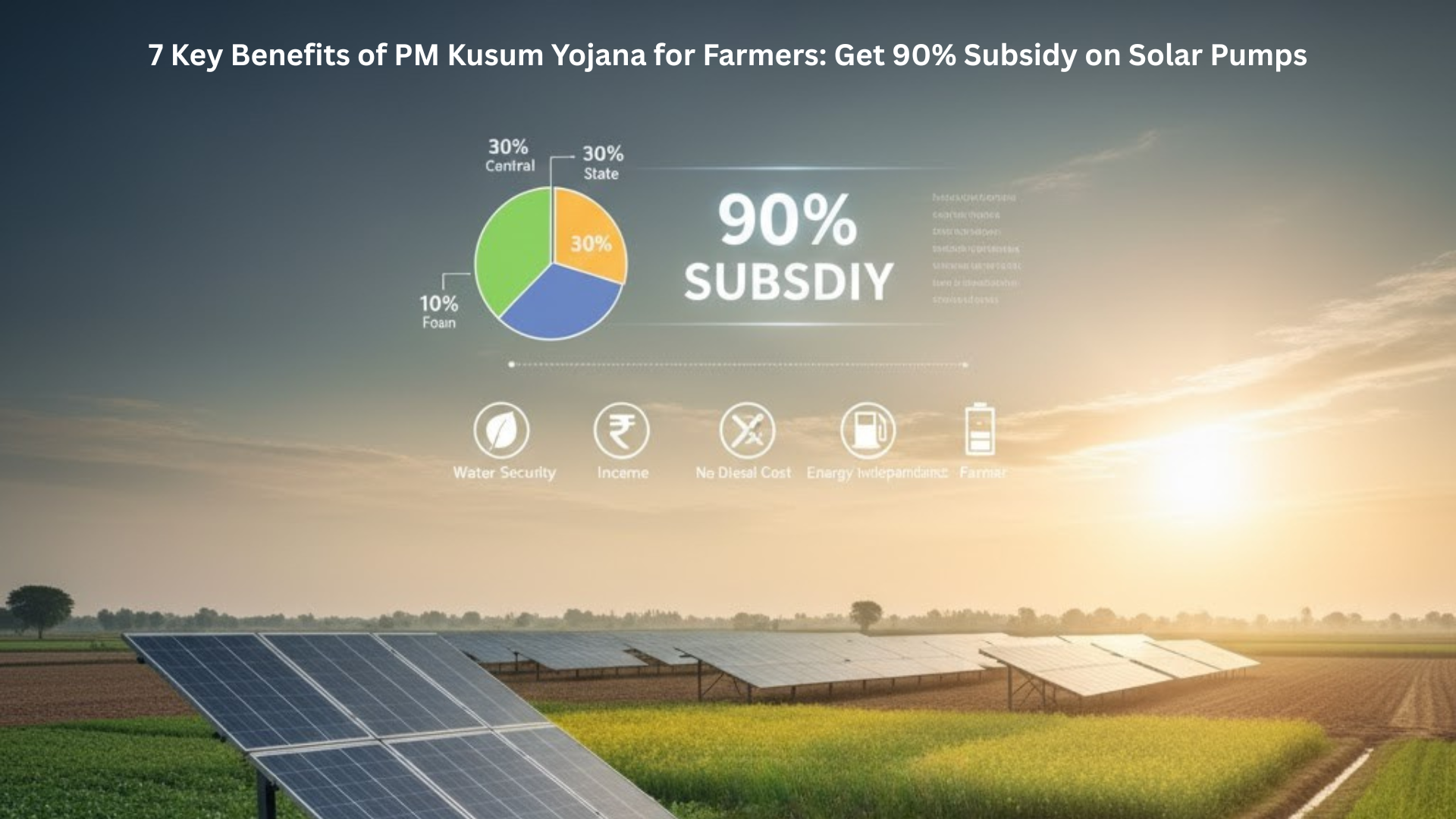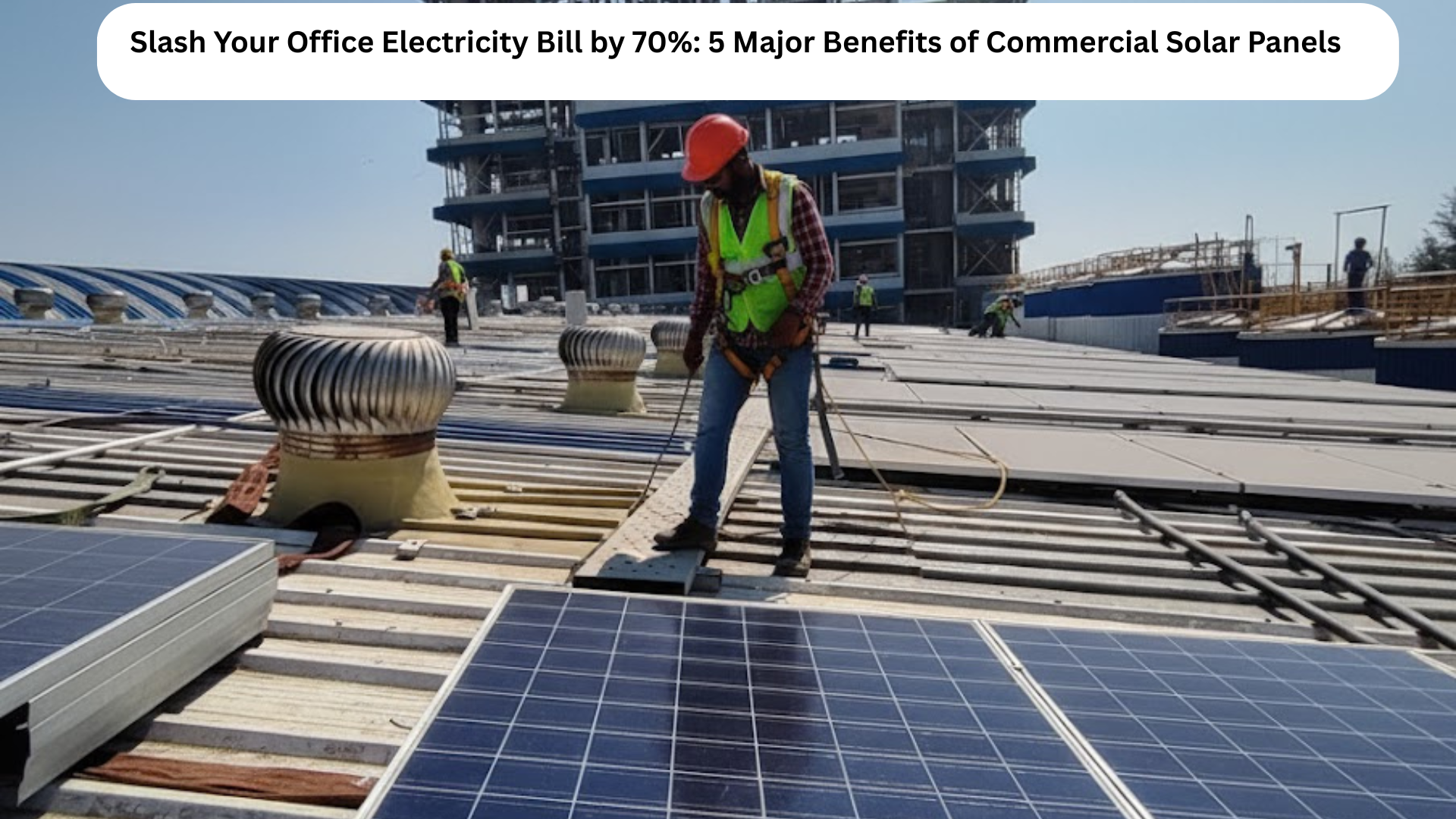India is on an unstoppable journey towards solar energy. Schemes like the PM-Surya Ghar Muft Bijli Yojana have made rooftop solar accessible, not just to reduce electricity bills, but to achieve genuine energy independence. But once you decide to ‘go solar,’ you face the most critical decision: which type of solar panel is right for your home?
Choosing correctly means maximizing power generation on your limited rooftop space, securing reliable performance through scorching summers, and achieving the fastest Return on Investment (ROI). Choosing incorrectly means slower savings and a system that underperforms when you need it most.
This ultimate guide breaks down the three dominant types of solar panels in India—Monocrystalline, Polycrystalline, and the modern PERC technology—to give you the clarity needed to invest wisely in 2025.
1. The Foundation: Understanding the Two Traditional type of solar panel
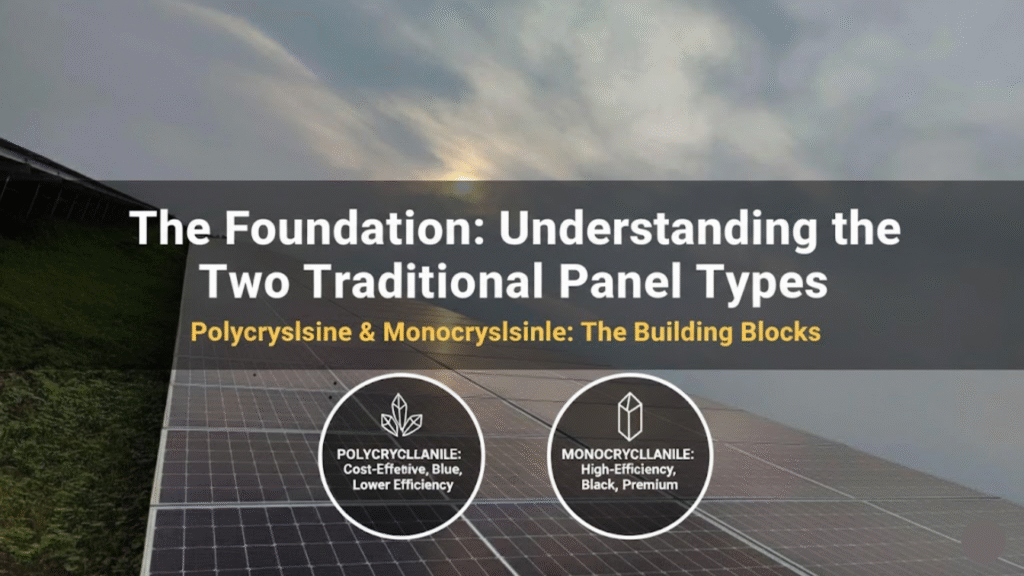
The core difference between solar panels lies in how their silicon cells are manufactured. This manufacturing process dictates everything, from their efficiency and aesthetics to how they handle the intense Indian heat.
A. Monocrystalline Solar Panels: The Premium type of solar panel
Monocrystalline panels are built from highly pure silicon. Their name, ‘mono,’ refers to the single, continuous crystal structure used to form the photovoltaic cell.
Key Features & Technical Breakdown:
- Manufacturing Process: A single, large, cylindrical ingot of pure silicon (created via the Czochralski method) is sliced into thin wafers. This high-purity, uniform process results in minimal crystal grain boundaries.
- Aesthetics and Appearance: Easily recognizable by their sleek, uniform dark black color and cells with rounded corners. They are highly preferred for modern urban homes due to their clean look.
- Efficiency: They typically boast the highest efficiency of traditional panels, ranging from 18% to 21%. The electrons have more freedom to move within the uniform crystal structure, converting sunlight into electricity more effectively.
- Performance in Low Light: Monocrystalline panels are known to perform better than Polycrystalline panels during dawn, dusk, and on cloudy days, making them a more reliable all-weather solution.
- Best Use Case: They are the classic choice for any homeowner with limited rooftop space who needs to maximize every square inch for power generation.
B. Polycrystalline Solar Panels: The Budget-Friendly type of solar panel
Polycrystalline panels (also known as multi-crystalline) take a different, more budget-friendly approach to manufacturing.
Key Features & Technical Breakdown:
- Manufacturing Process: The production is simpler and cheaper. Instead of a single crystal, molten silicon fragments are poured into a square mold and allowed to cool. This results in many crystals forming within a single cell.
- Aesthetics and Appearance: They have a distinctive blue, speckled appearance due to the visible boundaries of the multiple silicon crystals.
- Efficiency: Their efficiency is inherently lower than Monocrystalline, typically ranging from 15% to 17%. The multiple crystal boundaries create resistance, restricting electron movement.
- Cost Advantage: Because less silicon is wasted during the manufacturing process and the production is simpler, Polycrystalline panels have the lowest initial purchase price.
- Best Use Case: They are best suited for large-scale commercial or industrial installations where land or rooftop area is abundant and the absolute lowest capital expenditure (CAPEX) is the priority.
2. The Game Changer: PERC Technology — A New type of solar panel Upgrade
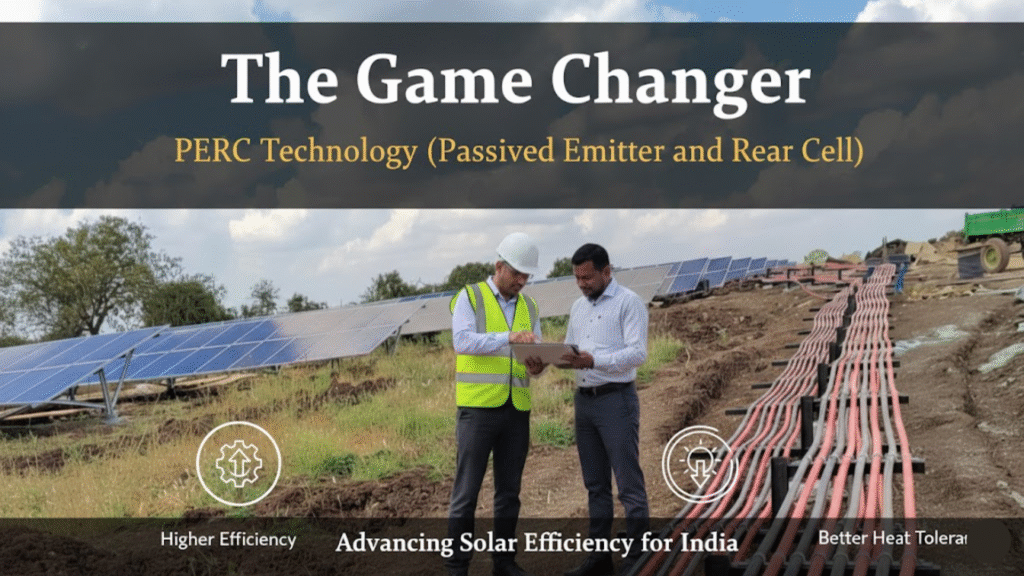
In the context of the Indian residential solar panel installation market in 2025, the comparison should rarely be just ‘Mono vs. Poly.’ The real conversation starter and the leading choice for a new solar installation is Mono PERC.
PERC is not a new type of panel material; it is a technology upgrade that is applied to the standard Monocrystalline cell (hence Mono PERC) type of solar panel.
What Exactly is PERC and How Does it Work?
Imagine a solar cell is a sponge trying to soak up all the sunlight. In traditional solar cells, some light passes straight through the cell without being absorbed.
- The PERC Upgrade: Manufacturers add a thin Passivation Layer (a non-conductive layer) and a layer of aluminum foil to the rear surface of the Monocrystalline cell. This upgrade is a key factor in improving the overall efficiency of your solar installation.
- Internal Reflection: This rear layer acts like a mirror. Any sunlight that passes through the cell without being converted into electricity is reflected back into the cell. This optimized light capture directly impacts the performance of your solar panel installation.
- The Second Chance: The reflected light is given a ‘second chance’ to be captured by the silicon, significantly increasing the overall energy conversion.
PERC’s Critical Advantages for the Indian Homeowner:
- Efficiency Boost: PERC effortlessly pushes efficiency beyond the 20% mark, often reaching 21% to 22.5%. This means you get more Watts from the same rooftop area, maximizing the output from your solar installation.
- Better High-Temperature Performance: This is the single most crucial advantage for India. The Passivation Layer reduces the amount of heat absorbed by the cell, and the reflective layer minimizes electron recombination, which is the main cause of power loss in high temperatures. Mono PERC panels lose less power than standard panels when temperatures soar above 25∘C, ensuring consistent performance from your solar panel installation.
- Enhanced Low-Light Performance: The internal reflection mechanism helps the panel capture light more effectively during early mornings, late evenings, and cloudy weather. This contributes to a more robust and reliable solar installation throughout the day.
3. The 2025 Standard: Half-Cut Cell Technology
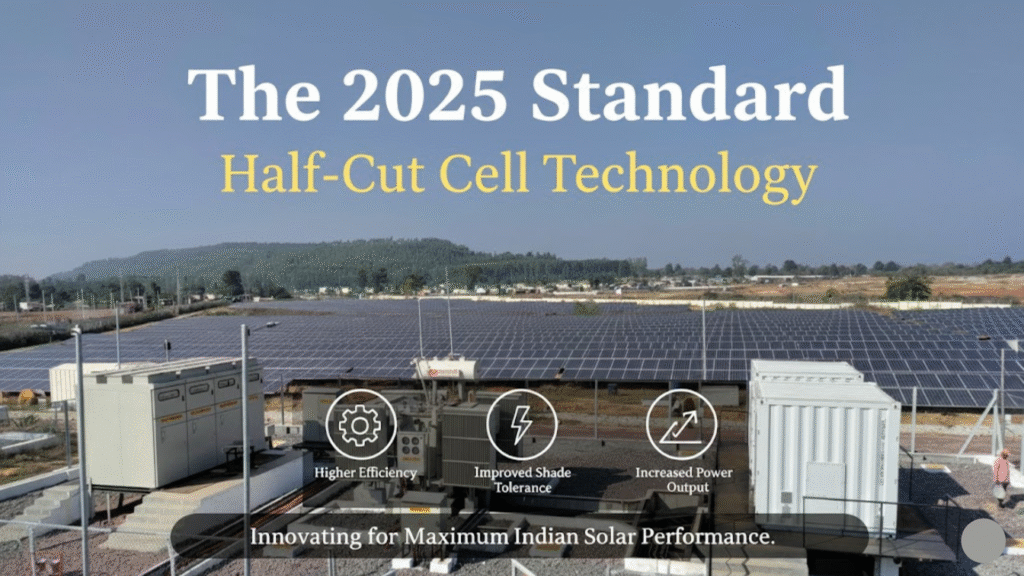
To provide a complete picture of the modern Indian solar market, we must look beyond just Mono/Poly/PERC. Most high-capacity panels sold today—especially the popular 550W modules—integrate an additional feature: Half-Cut Cells.
What are Half-Cut Cells?
Instead of using 60 or 72 full-sized cells, the panel uses 120 or 144 cells that are cut in half using a laser.
| Feature | Impact on Indian Rooftops |
| Reduced Resistance | Halving the cell halves the current, which in turn reduces internal resistance and power loss. This means the panel runs cooler and produces more power. |
| Improved Shade Tolerance | This is key for urban rooftops with partial shading (from chimneys, water tanks, or nearby buildings). The panel is wired into two independent halves. If the bottom half is shaded, the top half continues to produce power at full capacity, minimizing overall system loss. |
| Higher Output: | The combination of Mono PERC and Half-Cut technology creates the current market leader: the Mono PERC Half-Cut Panel. |
4. Comprehensive Comparison: Mono vs Poly vs PERC (The Final Breakdown)
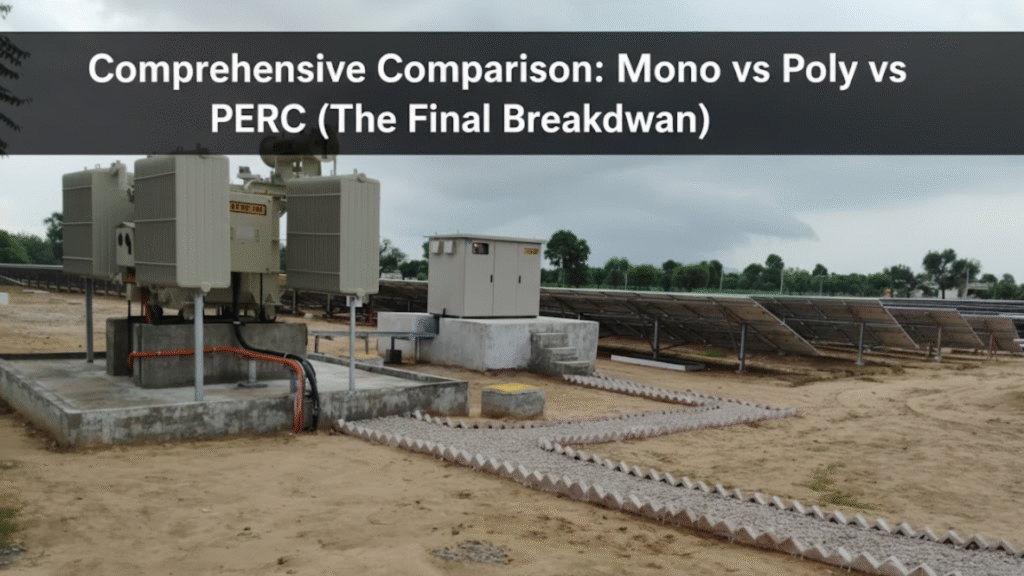
The table below summarizes the key metrics every Indian homeowner should consider before finalizing their purchase decision.
| Feature | Polycrystalline (Cost-Focused) | Monocrystalline (Aesthetics/Space) | Mono PERC Half-Cut (Best Value/Performance) |
| Typical Efficiency | 15%−17% | 18%−20.5% | 20.5%−22.5%+ |
| Relative Cost (Initial) | Lowest | Medium to High | Medium to High |
| Performance in High Heat | Fair (Highest degradation) | Good | Excellent (Lowest power loss) |
| Space Required for 5kW | Largest area (requires 350−400 sq. ft.) | Smaller area (requires 300−350 sq. ft.) | Smallest area (requires 280−320 sq. ft.) |
| Shade Tolerance | Low | Low | High (due to Half-Cut wiring) |
| Aesthetics | Blue, highly visible pattern | Dark Black, rounded cells | Dark Black, sleek, uniform |
| Recommended Use | Very large open systems, very strict budget | Good system if PERC is unavailable | Most recommended for Residential Rooftops |
5. The Ultimate Verdict for Your Indian Home in 2025
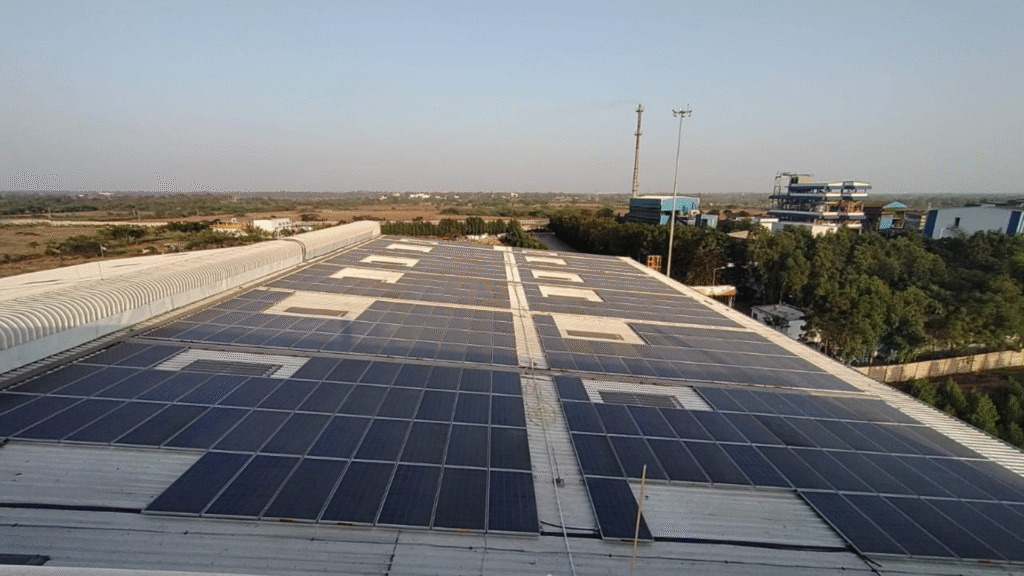
The best solar panel is the one that gives you the quickest payback and the most reliable power over 25 years. Based on performance, cost trends, and technology advancements, the choice is clear:
🏆 The Recommended Choice: Mono PERC Half-Cut Panels
Why?
- The Temperature Factor: India experiences severe heat waves. Your panels must work efficiently when the sun is at its peak. Mono PERC is engineered to minimize heat-induced power loss, ensuring you get maximum production during critical afternoon hours.
- The Space Factor: Most urban homes in India have limited rooftop space, often shared with water tanks, satellite dishes, and vents. High efficiency is non-negotiable, and Mono PERC provides the best power output per square meter.
- The Resilience Factor: The addition of Half-Cut technology makes the panel significantly more robust against partial shading, which is a very common issue on residential rooftops. If a small part of the panel is shaded, the entire system doesn’t shut down.
Expert Insight:While Polycrystalline offers the lowest purchase price, the lifetime savings from the higher efficiency and better heat performance of a Mono PERC system almost always result in a better long-term ROI for the residential consumer.
6. Looking Ahead: The Future of Solar (N-Type TOPCon)
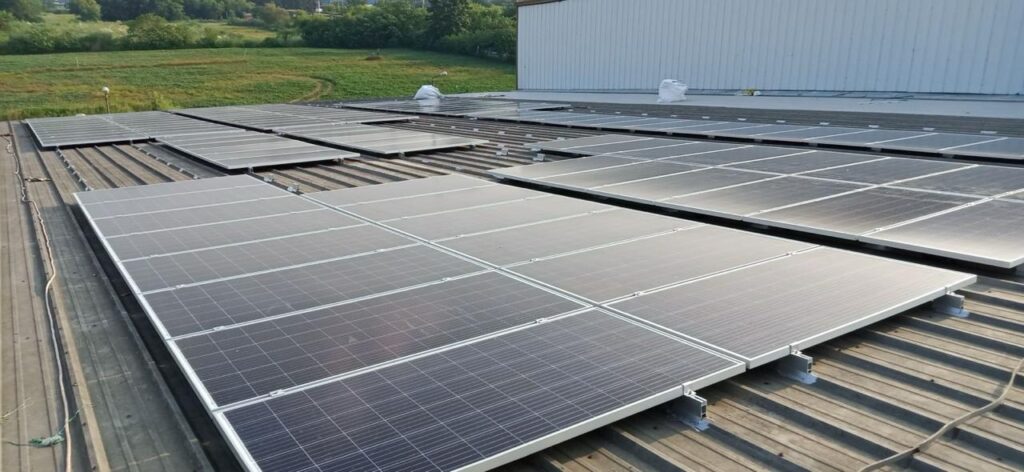
If you are a technology enthusiast or have a premium budget, the absolute latest in solar technology is starting to enter the Indian market: N-Type TOPCon (Tunnel Oxide Passivated Contact).
Why N-Type TOPCon is the Next Big Thing:
- Super High Efficiency: N-Type cells can push efficiency to 23%−24%, outperforming P-Type PERC cells.
- Negligible Degradation: They suffer less from Light Induced Degradation (LID), meaning the panel maintains its output for longer over its 25-year life.
- Superior Heat Performance: N-Type cells have an even lower temperature coefficient than PERC, making them the ultimate performer in extreme heat.
In 2025, N-Type TOPCon panels are slightly more expensive than Mono PERC, but the cost difference is shrinking rapidly. For those building a solar system for a lifetime of premium performance, this is the technology to ask for.
Frequently Asked Questions (FAQ)
Q1. Is Polycrystalline completely outdated for home use?
A. While not technically ‘outdated,’ Polycrystalline technology is no longer the preferred choice. The price difference between Poly and Mono PERC has become so small that the significantly lower efficiency and performance in high heat of the Poly panel rarely justifies the marginal saving for a typical home installation.
Q2. What is the single most important specification for solar panels in the Indian climate?
A. The most important specification is the Temperature Coefficient (stated in %/∘C). This number tells you how much the panel’s power output drops for every degree the temperature rises above 25∘C. Look for a low number, such as −0.35%/∘C or better. The lower the number, the better the panel handles the high Indian temperatures.
Q3. How important is the panel’s power rating (e.g., 550W)?
A. The Wattage (e.g., 550W) is the maximum power output, but the efficiency percentage is often more important. A 550W panel that is 21% efficient is better than a 500W panel that is 18% efficient, especially on a small roof, because the higher efficiency means the panel takes up less space to deliver its power.
Q4. Should I worry about the aesthetics of the solar panels?
A. If your panels are clearly visible from the street, aesthetics matter. Monocrystalline and Mono PERC panels have a uniform black color and a clean look that integrates seamlessly with modern roofing. Polycrystalline panels, with their blue and speckled look, are generally considered less appealing.
Q5. What is the minimum warranty I should demand?
A. You must demand two warranties:
- Product Warranty (10-12 Years): Covers manufacturing defects and panel faults.
- Performance Warranty (25 Years): Guarantees that the panel will still produce at least 80%−85% of its original power output after 25 years. Always choose a company that has been in the market long enough to honor this long-term commitment.

